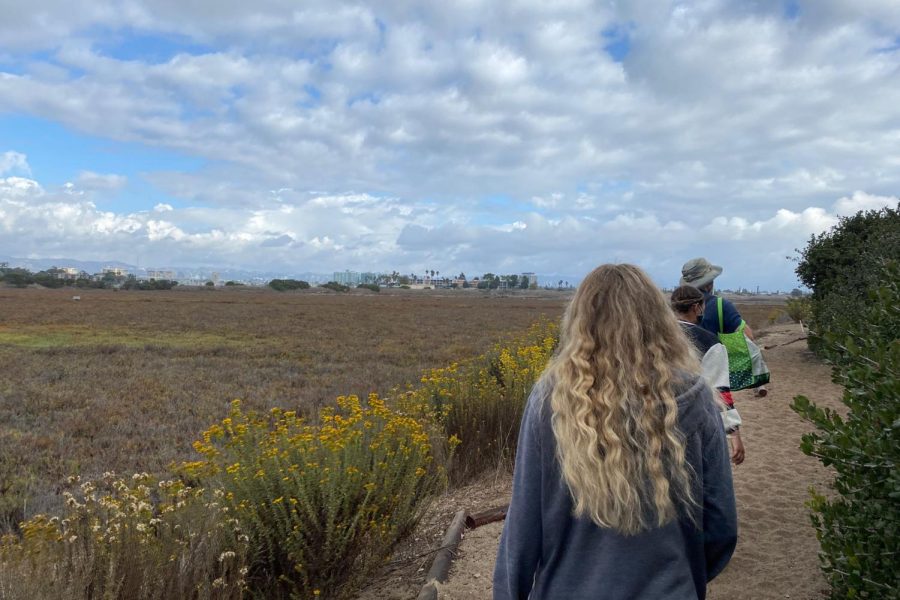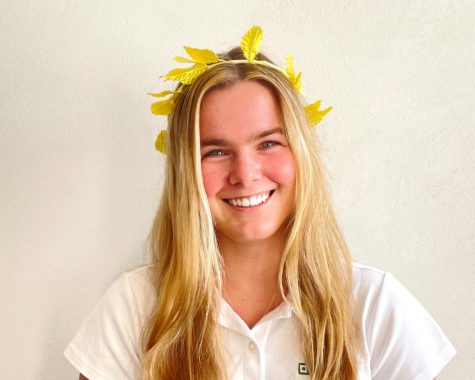Sustainable living and design class takes field trip to Ballona Wetlands
Photo credit: Grace Doyle
Senior Emilia Ramirez walks along the Ballona Wetlands saltwater marsh on her way to collect data with the water quality group. Senior Isabella Specchierla from the plant composition group enjoyed her time at the wetlands. “It’s been amazing”, Specchierla said. “I’ve learned so much about new plants that I’ve never seen before.”
October 26, 2021
With weeks of knowledge in their back pocket, seniors from the sustainable living and design science class traveled to the Ballona Wetlands in Marina Del Rey to put their learning into action. Groups split up into research topics to hone their knowledge about ecosystems and ecological services. The class takes “an interdisciplinary look at [what it means to be sustainable] and guide[s] students to live and act in ways that foster social, economic and environmental well-being,” according to the class syllabus.
Before leaving for their field trip on Oct. 18, students divided into three groups to research one of the following general topics: water quality, plastic pollution or plant composition. They had a couple of days to research, create a hypothesis and create a data collection method. They also put together a data table to be utilized during their trip.
Patrick Terrell is the manager of habitat restoration and upper education with the Friends of the Ballona Wetlands. Terrell started the senior visit with a presentation on the history of the wetlands and spoke about the importance of environmental education. When seniors broke into their research groups to collect data, he went with the water quality group. He guided students with their data collection of water factors, including salinity, lead, alkalinity, mercury, dissolved oxygen, temperature and PH level.
“Classroom learning is critical, but actually getting out into the real work and sometimes literally getting your hands dirty … takes stuff that’s more conceptual and more abstract, and you get a real-world application,” Terrell said. “And that makes the learning part of the classroom click and makes it more real.”
Katherine Hannibal, a researcher in residence and science teacher at Archer, planned the class excursion along with sustainable diving and design teacher Casey Huff.
“We really wanted to think about how to get [students] to have some hands-on learning experiences,” Hannibal said. “And something that ties into what we are learning. […] Where in Los Angeles or Southern California could we go to find a space where you could see that happening in action? The Ballona Wetlands are super close so it seemed like a great place.”
Senior Isabella Specchierla partook in research with her plant composition group prior to leaving for Marina Del Ray. They researched biodiversity within the wetlands and human impacts before putting their background information into practice.
“We were looking at different species of plants, native species versus non-native species, and investigating the amount of foreign plant,” Specchierla said. “We used a quadrant to measure and found that there were a lot more non-native species that are overtaking the native species of plants.”
After collecting data from the wetlands, students are required to present their findings to the class as well as spread their message to a broader community. Whether that be with posters around the school, on social media, or even talking with people in person, “science communication” was a central pillar behind the field trip, Hannibal said.
“We had the idea of thinking about, why are we doing this? We always want to have a why behind the activities that we have [students] do,” Hannibal said. “We thought about science communication and how that is a really important frontier of science in general … so we thought about how can we mix other the quantitative hard science with science communication aspect.”
Speaking about what she hopes students took away from the experience, Huff noted how science is all around us. The trip was a way to foster that understanding.
“It’s one thing to learn science and I feel sometimes science, as least for me, for so long [seemed] like it only happens in a lab in these very controlled situations,” Huff said. “But in actuality, it is happening around us at all times, and you are interacting with science and the consequences of human choice constantly.”
One takeaway of Specchierla’s was the need to bring more “awareness” to environmental issues. The Ballona Wetlands served as an important part of that goal, Specchierla said.
“We’re almost about to go to college and into the real world and I think applying this to our lesson in college and bringing awareness to new people that we meet in the real world is really important,” Specchierla said.
Overall, an understanding of the wetlands was Terrell’s main hope for the students. He highlighted the need to protect the wetlands and furthermore, the need for people to care.
“I hope [students] loved the Ballona Wetlands and learned a little bit about the place and why it’s important and why we need to protect these areas,” Terrel said. “[…] this is a really important mission-based career but barring that, [I hope students] care about what’s going on here and understand why it’s important.”









